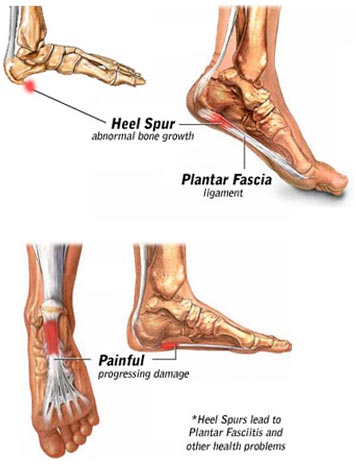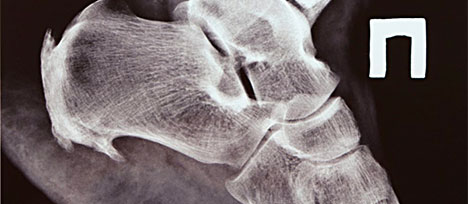Heel or Toe Bone Spurs
 When you experience pain in your foot, it may be caused by bone spurs. These nagging bumps can arise from a wide range of sources, so it’s best to visit an experienced Midtown Manhattan podiatrist for evaluation and a proper diagnosis. Sometimes a blunt injury to your foot result in a bone spur, but most times, bone spurs are the result of a ligament, tendon or fascia pulling on bone causing reactive bone to grow in the direction of pull. Bone spurs often form on your heels or toes and can become painful. Heel spurs are typically found on the back of the heel where the Achilles tendon attaches or at the bottom of the heel where the plantar fascia connects. Toe spurs most frequently occur in the little toe and often causes irritation in shoes. All symptoms should always be evaluated with a thorough consultation and examination by your podiatrist for an accurate diagnosis and treatment plan to exclude any underlying serious condition.Bone spurs are the result of a ligament, tendon or fascia pulling on bone causing reactive bone to grow in the direction of pull.
When you experience pain in your foot, it may be caused by bone spurs. These nagging bumps can arise from a wide range of sources, so it’s best to visit an experienced Midtown Manhattan podiatrist for evaluation and a proper diagnosis. Sometimes a blunt injury to your foot result in a bone spur, but most times, bone spurs are the result of a ligament, tendon or fascia pulling on bone causing reactive bone to grow in the direction of pull. Bone spurs often form on your heels or toes and can become painful. Heel spurs are typically found on the back of the heel where the Achilles tendon attaches or at the bottom of the heel where the plantar fascia connects. Toe spurs most frequently occur in the little toe and often causes irritation in shoes. All symptoms should always be evaluated with a thorough consultation and examination by your podiatrist for an accurate diagnosis and treatment plan to exclude any underlying serious condition.Bone spurs are the result of a ligament, tendon or fascia pulling on bone causing reactive bone to grow in the direction of pull.
”
★ ★ ★ ★ ★Very kind, courteous and professional. Saw me promptly and made sure to talk me through diagnosis and at-home care.
Heel spur pain can flare up intermittently or chronically when you’re doing a strenuous activity like power walking, jogging or running. When you experience If you’re experiencing heel or toe pain from a bone spur, your foot doctor can diagnose your foot issue and recommend the appropriate treatment. When you discuss your condition or heel pain, you will learn what contributed to the development of your heel or toe spurs and how to prevent future occurrences and worsening of the condition.
Typical Causes of Bone Spurs
Common risk factors associated with heel and toe spurs include:
- Jogging or running, especially on paved or hard surfaces
- Walking abnormalities — such as an usual gait or poor walking posture — that put extra stress on your heel and toe bones
- Obesity and excessive weight
- Shoes with no arch support
- Shoes that are worn out or fit poorly
- Certain foot types such as flat feet or cavus foot
Leading foot doctors caution you about additional risk factors linked to plantar fasciitis:
- Advanced age, as age decreases flexibility in your plantar fascia and contributes to thinning of the protective padding of fat in your heel
- Diabetes
- Extended periods of time on your feet
- Frequent bursts of physical exertion without warming up
- Having high arches or flat feet
Symptoms Associated with Heel and Toe Spurs

Pain is the most common symptom of a heel or toe spur but you may notice a hard bump under the skin which can become irritated in certain shoes. Heel spur pain can flare up intermittently or chronically when you’re doing a strenuous activity like power walking, jogging or running. Some people describe pain from toe or heel spurs as a pin or knife poking them in the bottom of their feet, especially when they stand up out of bed in the morning. The symptoms may return later as a dull ache in your heel or toe.
If you see inflammation during physical activities, find the best foot doctor possible in New York as soon as you can. Inflammation may also be a symptom of other soft-tissue conditions in your foot, so it’s important to visit the best podiatrists in Manhattan to receive a proper diagnosis.
Diagnosis of Toe and Heel Spurs
Your podiatrist considers many factors when diagnosing you for toe or heels spurs — including your pain level, your overall health, your genetic disposition (whether any relatives have had foot issues) and any tenderness in the area of your bony protrusion.
The foot doctor may examine your foot with an MRI or X-rays to identify the spur on the toes or heel bone. Bone spurs may also show up in examinations by your foot doctor with ultrasound imaging, CT scans and myelograms — a process that uses dyes for contrast that appear in X-rays and MRIs.
Treating Heel and Toe Spurs
Unfortunately, the pain caused by heel and toe spurs doesn’t decrease with rest. It can actually feel worse after sitting or when you wake up in the morning. Your plantar fascia tissue stretches when you place your foot on the grouns, which puts extra stress on your heel. The pain may decrease the more you walk, but people with this condition often feel the pain come back after a prolonged rest or additional walking.
Our Manhattan podiatry specialists may advise the following treatments for toe and heel spur-related conditions, depending on your situation:
- Exercise
- Anti-inflammatory medications
- Custom-made orthotics
- Cortisone injections
If your pain doesn’t respond to any of these treatments, you may need a surgical procedure. Consult your podiatrist, but if your pain persists for over a month, try additional treatments before surgery, including:
- Taping your feet to ease the stress on your tendons and muscles
- Foot stretching exercises
- Recommendations for more comfortable shoes
- Physical therapy
Toe and heel pain can also be reduced by over-the-counter pain killers and anti-inflammatories such as Tylenol (acetaminophen), Aleve (naproxen) or Advil (ibuprofen). These medications provide short-term pain relief only and should be discussed with your medical doctor prior to use.
Surgery for Toe and Heel Spurs
The two most common surgical techniques for chronic heel pain are removing the bone spur itself and surgery releasing the band of plantar fascia. The success rate for heel and toe spur surgery is more than 90 percent. Your podiatrist in NYC recommends surgery only if conservative, non-surgical treatments fail after a period of 6-12 months. The two most common surgical techniques for chronic heel pain are removing the bone spur itself and surgery releasing the band of plantar fascia. Seek the best foot doctor in the NYC area. Get a full examination, diagnosis and treatment recommendation before deciding, but remember that conservative treatments are the place to start. Only if they don’t provide any relief should you agree to surgery.
Important Reminder: This information is only intended to provide guidance, not definitive medical advice. Please consult foot doctor about your specific condition. Only a trained, experienced board certified podiatrist or foot specialist can determine an accurate diagnosis and proper treatment.
Do you have any questions about Heel or Toe Bone Spurs treatment in NYC? Would you like to schedule an appointment with an internationally recognized, top NYC Podiatrist and foot doctor at Manhattan Foot Specialists? Please contact our office for consultation.
In The Press

Call now to make an appointment with our award winning, board certified NYC podiatrists regarding your health. We look forward to seeing you!
book online now (212) 389-9918(212) 389-1886 Podiatrist (Midtown) 51 East 25th Street, Ste 451, NY 10010
(212) 389-1887 Podiatrist (Union Square) 55 W 17th St Ste 106, NY 10011
(212) 378-9991
